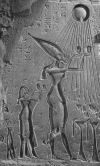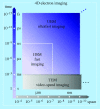Micrographia of the twenty-first century: from camera obscura to 4D microscopy
- PMID: 20123754
- PMCID: PMC3263811
- DOI: 10.1098/rsta.2009.0265
Micrographia of the twenty-first century: from camera obscura to 4D microscopy
Abstract
In this paper, the evolutionary and revolutionary developments of microscopic imaging are overviewed with a perspective on origins. From Alhazen's camera obscura, to Hooke and van Leeuwenhoek's two-dimensional optical micrography, and on to three- and four-dimensional (4D) electron microscopy, these developments over a millennium have transformed humans' scope of visualization. The changes in the length and time scales involved are unimaginable, beginning with the visible shadows of candles at the centimetre and second scales, and ending with invisible atoms with space and time dimensions of sub-nanometre and femtosecond. With these advances it has become possible to determine the structures of matter and to observe their elementary dynamics as they unfold in real time. Such observations provide the means for visualizing materials behaviour and biological function, with the aim of understanding emergent phenomena in complex systems.
Figures





Similar articles
-
Perspective: 4D ultrafast electron microscopy--Evolutions and revolutions.J Chem Phys. 2016 Feb 28;144(8):080901. doi: 10.1063/1.4941375. J Chem Phys. 2016. PMID: 26931672
-
From Animaculum to single molecules: 300 years of the light microscope.Open Biol. 2015 Apr;5(4):150019. doi: 10.1098/rsob.150019. Open Biol. 2015. PMID: 25924631 Free PMC article. Review.
-
Homage to Robert Hooke (1635-1703): new insights from the recently discovered Hooke Folio.Perspect Biol Med. 2009 Summer;52(3):392-9. doi: 10.1353/pbm.0.0096. Perspect Biol Med. 2009. PMID: 19684374
-
Positioning Van Leeuwenhoek's microscopes in 17th-century microscopic practice.FEMS Microbiol Lett. 2022 Apr 21;369(1):fnac031. doi: 10.1093/femsle/fnac031. FEMS Microbiol Lett. 2022. PMID: 35325115
-
Chapter 33: the history of movement disorders.Handb Clin Neurol. 2010;95:501-46. doi: 10.1016/S0072-9752(08)02133-7. Handb Clin Neurol. 2010. PMID: 19892136 Review.
Cited by
-
The Arabs' scientific vision.Nat Mater. 2014 Apr;13(4):317. doi: 10.1038/nmat3940. Nat Mater. 2014. PMID: 24651413 No abstract available.
-
Reflections on the value of electron microscopy in the study of heterogeneous catalysts.Proc Math Phys Eng Sci. 2017 Jan;473(2197):20160714. doi: 10.1098/rspa.2016.0714. Proc Math Phys Eng Sci. 2017. PMID: 28265196 Free PMC article. Review.
-
High speed direct imaging of thin metal film ablation by movie-mode dynamic transmission electron microscopy.Sci Rep. 2016 Mar 11;6:23046. doi: 10.1038/srep23046. Sci Rep. 2016. PMID: 26965073 Free PMC article.
References
-
- Al-Hassani S. T. S., Woodcock E., Saoud R. 1001 inventions:Muslim heritage in our world. Manchester, UK: Foundation for Science, Technology and Civilisation; 2006.
Publication types
MeSH terms
LinkOut - more resources
Full Text Sources

